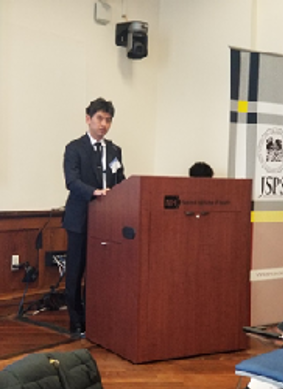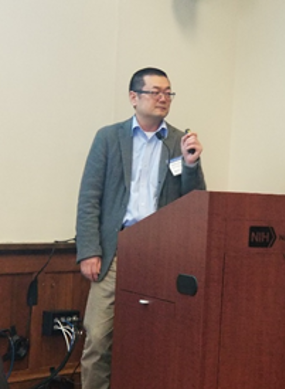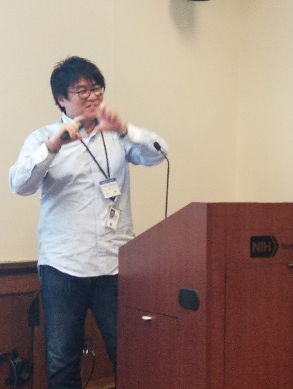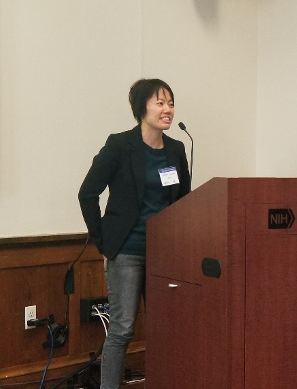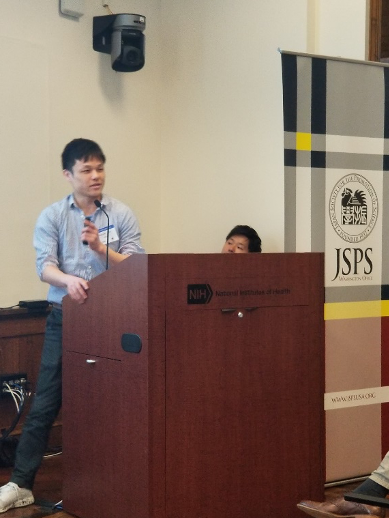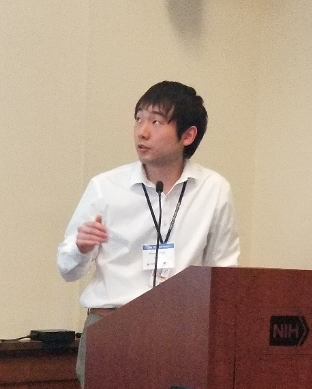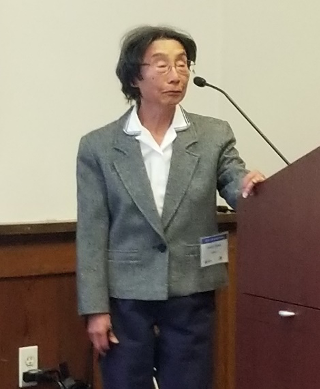The Japan Society for the Promotion of Science (JSPS) Washington Office and the Fogarty International Center (FIC) at the National Institutes of Health (NIH) held the 2020 JSPS-NIH Forum on March 6, 2020 at the Cloister at the Bethesda, Maryland NIH campus.
The JSPS-NIH Fellowship for Japanese Biomedical and Behavioral Researchers at NIH (JSPS-NIH Fellowship or “Kaitoku-NIH”) is an annual fellowship that provides funds for about ten Japanese biomedical and behavioral scientists to conduct two years of research at NIH. JSPS and NIH have jointly supported the research fellows
The 2020 Forum featured invited speaker presentations from Dr. Takeshi Sakamoto of Wayne State University and Dr. Yoh-suke Mukouyama of the National Heart, Lung, and Blood Institute (NHLBI). The invited speakers were followed by lectures by three prominent JSPS-NIH research fellows, who spoke about their research accomplishments since they participated in the fellowship program. The ten incoming fellows that were awarded in FY2019 then spoke about their research plans for their fellowship period at NIH.
The Forum began with opening remarks by Dr. Kohji Hirata, the Director of the JSPS Washington Office; Mr. Seiichi Shimasaki, the Science Counselor of the Embassy of Japan in the US; and Dr. Yoh-suke Mukouyama, Senior Investigator at NHLBI and Chair of the Review Panel of the JSPS-NIH Fellowship. The opening speakers congratulated the new awardees and expressed their hopes that the new generation of researchers will help to pave the way for the future of biomedical research.
Dr. Mukouyama also commemorated the life of Dr. Yoshi Yamada, who passed away in December 2019. Dr. Yamada had a 40-year career as a distinguished senior investigator at the NIH, where he trained and mentored many young Japanese scientists who have since become leaders in their own right, including many JSPS-NIH fellows. Dr. Yamada was also instrumental in organizing NIH’s support for the Japanese research community after the March 2011 earthquake and tsunami disasters.
Opening Remarks (Mr. Seiichi Shimasaki, Embassy of Japan in the US)
■ Invited Speaker #1: Dr. Takeshi Sakamoto, Wayne State University
Dr. Sakamoto described his work in measuring a traction force of cell migration (cell motility), which supports research on the body’s development as an embryo, immune responses, wound healing, and resistance to cancer cells. Dr. Sakamoto’s lab developed its software to improve the measurement process for cell migration. His team uses fluorescently-labeled magnetic beads as markers because their properties make them rise to the surface of the substrate used for traction detection. The team’s software then measures each beads’ position and calculates the displacement and the force of each bead to directly measure the amount and direction of the force.
Compared with Particle Image Velocimetry (PIV), which is the most popular software method to measure cell migration, Dr. Sakamoto’s team was able to improve spatial resolution and measurement accuracy, reduce the background noise, and could measure the amount of the traction force. The team also drastically shortened the processing time for analyzing the traction force microscopy (TFM) data from about 10 hours to 1 minute. Dr. Sakamoto’s findings were published in the February 2020 issue of the Biophysical Journal 1.
Dr. Takeshi Sakamoto, Wayne State University
■ Invited Speaker #2: Dr. Yoh-suke Mukouyama, NHLBI
Dr. Mukouyama kindly presented at the Forum since Dr. Hiroaki Wake of the Nagoya University Graduate School of Medicine was unable to travel to the United States due to unforeseen circumstances.
Dr. Mukouyama first presented Dr. Wake’s work to characterize microglia in a healthy brain. Microglia are a type of immune response cell or specialized macrophage that is located in the brain and spinal cord of the central nervous system and plays a role in neural development. They are typically studied as part of research on neurodegenerative and infective diseases of the brain. Dr. Wake used in vivo optical imaging tools to study microglia in living mice to illuminate the physiological and pathological functions of microglia in a healthy brain.
Dr. Mukouyama then presented his research on the macrophage control of brain development. Macrophages are a type of white blood cell that cleans the body of unwanted microscopic particles, such as bacteria and dead cells. As mentioned above, microglia are a type of CNS macrophages. Dr. Mukouyama examined cell clusters of macrophages in the central nervous system (CNS) to explore their role in brain development. His research team focused on whether a type of cell expressing a hyaluronan receptor, LYVE-1, which plays a role in immune response, has properties of CNS macrophages. They found that the LYVE-1-expressing cells express CNS macrophage markers as well as immune response genes and inflammatory responses. The research team also found evidence of communication between the CNS macrophages and the radial glia cell (RGC), neural stem cell in embryonic brain that is key to cortical development, indicating the importance of CNS macrophages in healthy brain development.
Dr. Yoh-suke Mukouyama, National Heart, Lung, and Blood Institute (NHLBI)
■ Presentations on Research Progress by JSPS-NIH Research Fellows (KAITOKU-NIH)
Three JSPS-NIH research fellows spoke about their research accomplishments: Dr. Tomoko Ikeuchi of the National Institute of Dental and Craniofacial Research (NIDCR) (FY2014); Dr. Kazuya Ono of the NIDCD (National Institute on Deafness and Other Communication Disorders) (FY2015); and Dr. Morie Ishida of the Eunice Kennedy Shriver National Institute of Child Health and Human Development (NICHD) (FY2016).
Dr. Ikeuchi presented on her research to characterize the pathogenic immune drivers and potential therapeutic targets for periodontitis. Periodontitis is one of the most common inflammatory diseases in humans, but its causes are not completely understood. Dr. Ikeuchi has found that signaling by a type of protein called IL-17 mediates the inflammatory bone loss in periodontitis, and she is now determining the specific non-immune cell types involved in the process.
Dr. Tomoko Ikeuchi (FY2014 JSPS-NIH Fellow), National Institute of Dental and Craniofacial Research (NIDCR)
Dr. Ono spoke about his work with live mice to test how ear sensory organs are encoding sensory inputs for balance, such as detecting sudden “jerk” movements of the head. He has found that some of the specialized central regions in the ear sensory organs were essential for detecting jerk, but not for some other reflexes related to balance.
Dr. Kazuya Ono (FY2015 JSPS-NIH Fellow), National Institute on Deafness and Other Communication Disorders (NIDCD)
Dr. Ishida presented on his work in membrane tracking in eukaryotic cells. His focus was on proteins which do not follow the typical pathways and instead follow a path called “retrograde transport.” This rare situation typically occurs for toxins such as ricin and shigatoxin. Mutations in genes that function in retrograde transport can cause a neurodevelopmental disorder. Dr. Ishida identified the ARFRP1 gene as the master regulator for a key part of the retrograde transport process.
Dr. Morie Ishida (FY2016 JSPS-NIH Fellow), Eunice Kennedy Shriver National Institute of Child Health and Human Development (NICHD)
■ Presentations on Research Plan at NIH by JSPS-NIH Fellows (KAITOKU-NIH) Awarded in FY2019
The ten FY2019 JSPS-NIH fellowship recipients each gave brief “flash talk” presentations on their background and research plans. Their research covered a wide range of important issues in biomedicine, including studies on how ovarian cancer cells form resistance to drug treatments, studying how branched organs acquire their physiological functions during development, identifying the molecules that are involved in the progression of brain tumors, and improving the use of non-invasive metabolic imaging for tumor detection and response.
■ Closing Remarks by Dr. Keiko Ozato, Former Chair of Review Panel, NICHD
Dr. Ozato spoke about the value of the longstanding partnership between JSPS and NIH. She praised the opportunities that the fellowship provides to elevate the standing of Japanese researchers, and how the fellowship raises the global profile of Japanese scientific knowledge. She thanked JSPS and the NIH leaders and principle investigators that have worked to make the fellowship program so successful. Dr. Ozato shared her memories of Dr. Yoshi Yamada and his many contributions to NIH and to the fellowship program. She concluded her remarks by encouraging the new fellows to build wonderful relationships with their fellow scientists, to stand equal to famous PIs in the field, and to treasure optimism and the responsibility to do good and honest research as the main guiding forces for scientific progress.
Dr. Keiko Ozato, Former Chair of Review Panel, Eunice Kennedy Shriver National Institute of Child Health and Human Development (NICHD)
■ Reception: Honoring JSPS-NIH Fellows, Alumni, and the JSPS-NIH Collaboration
Immediately following the forum, the JSPS Washington Office hosted a reception for the presenters and attendees to socialize and discuss the forum presentations. At the start of the reception, Dr. Kohji Hirata, the Director of the JSPS Washington Office; Dr. Michael M. Gottesman, the Deputy Director for Intramural Research at NIH; and Dr. Peter Kilmarx, Deputy Director of the Fogarty International Center, each gave some opening remarks. The NIH speakers emphasized the special relationship between the U.S. and Japan, which has endured through crises such as the 3/11 earthquake and tsunami in Japan, which led to an outpouring of NIH support for their Japanese colleagues, as well as the ongoing coronavirus pandemic. They noted that the Diamond Princess cruise ship docked in Japan, which suffered from an early outbreak of the coronavirus, had many American passengers onboard that were evacuated from the ship to Japanese hospitals, and that the American passengers have been were very grateful to receive some of the best respiratory care in the world in Japan. They raised a toast to the continued strong relationship between NIH and the Japanese biomedical research community.
During the reception, several of the speakers shared their thoughts on their experiences as JSPS fellows and their advice for new fellows. Dr. Yoh-suke Mukouyama, the Chair of the Review Panel of the JSPS-NIH Fellowship, advised applicants for the fellowship to work with the PI that they hope to join to establish a solid research proposal beforehand, including deep discussions on topics such as experimental approaches and back-up plans in case of challenges.
Dr. Takeshi Sakamoto explained that working at NIH had provided him with opportunities to attend nearby conferences and workshops where he made many friends from the global research community. He encouraged young researchers in the fellowship program to use the opportunity to develop relationships with many different types of researchers outside of their own fields: not just for research, but to forge close friendships that will inspire them with new ideas.
Dr. Morie Ishida agreed that one of the greatest benefits of the fellowship was the networking opportunities at NIH. Dr. Kazuya Ono and Dr. Tomoko Ikeuchi both emphasized that the fellowship was an excellent opportunity for fellows coming straight out of PhD programs to learn how to write grant applications. Dr. Ikeuchi also noted that the opportunity to speak at the forum this year was very useful for her to think about how to describe her research to people outside of her field.
The FY2019 JSPS fellows also shared their future research plans and thoughts on the conference. Dr. Yuta Hikichi, an incoming fellow at the National Cancer Institute, explained that he sought out the fellowship because he hoped to conduct translational research on drug resistance at NIH alongside his mentor.
Dr. Mayu Kawai, an incoming fellow at the National Human Genome Research Institute (NHGRI), was grateful for the significant size of the grant, and the opportunity to continue her research at NIH. She enjoyed meeting several Japanese colleagues at the forum and hearing about the different kinds of research topics that were accepted by the fellowship committee.

